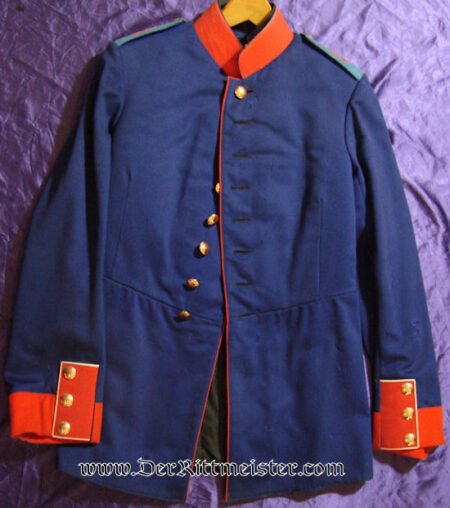Description
PRUSSIA – TUNIC – SENIOR NCO – KAISER FRANZ GARDE-GRENADIER-REGIMENT NR 2. This is a consignment item. It is a Senior NCO’s Kaiser Franz-Garde-Grenadier-Regiment Nr 2 tunic. This proud regiment was raised in 1814 during the Napoleonic Wars and named for Franz, Kaiser Franz Josef’s predecessor as Austro-Hungarian Emperor. It was garrisoned in the capital city of Berlin and, like all Garde-Regiments, assigned to the Garde-Korps.
The dunkel-blau tunic dates from about 1900. A total of eight gold-toned brass buttons run down the tunic’s center. A set of sewn-in loops for a three-inch wide ribbon bar appears on its left breast. The tunic sports kragenspiegel (collar patches) made of white cotton laid over a red felt/or wool background. Handsome gold bullion tape trims the collar, indicating the wearer’s NCO status. The same gold bullion tape appears on the cuffs, as well as three white/red patches of the same design as the collar’s kragenspiegel, each decorated with a gold-toned brass button.
The shoulder straps’ base color is red. Each strap’s center features Kaiser Franz’s royal cypher chain-stitched in yellow. A small brass button secures each shoulder strap to the tunic. Each button displays a “1” in its center indicating it is for Kompagnie Nr 1, the regiment’s honor kompagnie. The tunic’s reverse reveals six more gold buttons in its vent/flap area.
The tunic’s interior shows that its original liner has been removed. If this tunic has a fault, this is it. [The following is a speculation on my part]. Perhaps the lining was in such poor shape that a previous owner opted to remove it. The removal was neatly done, and reveals the tunic’s original, dark-blue wool material. Also, three of the buttonholes have been reinforced with leather patches on the interior. I have never seen this before. Although the lack of an interior liner is a factor, in reality, one rarely sees a tunic’s interior when it is on display. Greater consideration must be directed to the exterior.
This is a fine example of a prewar tunic worn by an NCO of a well-known Grenadier-Regiment.










